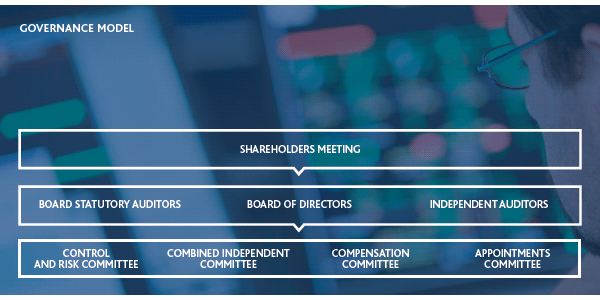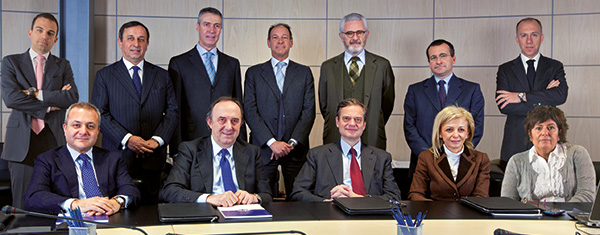Snam’s corporate governance system is based on the principles contained in the “Code of Conduct for Listed Companies” proposed by the Committee for the Corporate Governance of Listed Companies, with recommendations from the national financial regulator (Consob) on this topic and, more generally, taking into account international best practices. The model focuses particularly on compliance with the Unbundling Regulation, taking account of the specific features of Snam and its subsidiaries, which are regulated by the Electricity and Gas Authority. The Chairman’s duties are distinguished from those of the Chief Executive Officer, but both act as Company representatives pursuant to Article 19 of the Bylaws.
Detailed information on Snam’s corporate governance system is included in the “Report on corporate governance and ownership structure”, which is available on the website (www.snam.it).

BOARD OF DIRECTORS AND COMMITTEES
Snam’s Board of Directors, which was appointed by the Shareholders’ Meeting of 27 April 2010 and will remain in office until the Shareholders’ Meeting to approve the 2012 financial statements, comprises nine Directors, including eight non-executive directors (all except Carlo Malacarne, who holds the position of Chief Executive Officer). A third of the directors are appointed by minority shareholders, and five of them meet the criteria for independence set out in the regulations in force and the Code of Conduct. Gender diversity is represented by two female directors.
At the Board meeting of 15 October 2012, after the change in control of the Company, Chairman Salvatore Sardo and directors Alessandro Bernini and Massimo Mantovani tendered their resignations. At the same meeting, the Board co-opted three new non-executive directors: Lorenzo Bini Smaghi (appointed Chairman), Roberta Melfa and Andrea Novelli.
The Board is vested with the broadest powers for ordinary and extraordinary administration of the Company, including exclusive responsibility for defining the strategic guidelines and objectives and the approval of the respective business and financial plans. The powers that are not reserved for the Board of Directors or for the Chairman pursuant to law, the Bylaws or a Board resolution are delegated by it to the Chief Executive Officer of the Company.
The Board of Directors also plays a central role in defining sustainability policy, and reviews and approves the Sustainability Report, which is subsequently brought to the attention of the Shareholders’ Meeting. The Board met eight times in 2012, with average member attendance of 77.3%.
In order to carry out its functions more effectively, the Snam Board of Directors has created four committees within its ranks:
- Control and Risk Committee
- Remuneration Committee
- Appointments Committee
- Combined Independent Management Committee
The first three committees are provided for by the Code of Conduct and operate in accordance with its instructions.
The Combined Independent Committee is the collegiate body created for joint management of regulated activities involving natural gas transportation, dispatching, distribution, storage and regasification. This body, which comprises Snam’s Chief Executive Officer and the respective CEOs of GNL Italia, Italgas, Snam Rete Gas and Stogit, which are direct subsidiaries of Snam, has been granted full powers by Snam’s Board of Directors to perform its duties, and is governed by its own set of regulations.

SNAM COMMITTEE ACTIVITY
| Download XLS (15 kB) |
|
|
Meetings (no) |
Average member attendance (%) |
|
Control and Risk Committee |
9 |
92.67 |
|
Remuneration Committee |
4 |
83.33 |
|
Appointments Committee |
6 |
100 |
|
Combined Independent Management Committee |
3 |
100 |
CODE OF ETHICS AND MODEL 231
SO2
Snam and its subsidiaries have implemented rules on corporate administrative responsibility by adopting their own organisation, management and control model in accordance with Legislative Decree 231/2001, tailored to their specific situations. Each company has appointed its own Supervisory Body in charge of monitoring the model’s implementation and its actual application.
The Code of Ethics adopts the most modern approach to corporate ethics and sustainability, which is wholly consistent with the objective of implementing all of the values that the Company recognises, accepts and shares, and the responsibility that it assumes both internally and externally.
Added to the Snam Code of Ethics is a specific Addendum, which takes into account the specifics of the activities carried out by Snam and its subsidiaries, which are subject to regulation by the Electricity and Gas Authority. The Addendum places particular emphasis on relations with the Electricity and Gas Authority and the Unbundling Regulation.
Snam personnel, with no distinctions or exceptions, must observe these principles and ensure that others do the same.
In February 2012, a new text was approved for Model 231, after the reorganisation of the Snam group due to adoption of Legislative Decree 93/2011 and the introduction of environmental crimes into the body of Legislative Decree 231/2011. Snam’s Board of Directors has also made further amendments to Model 231 following Eni S.p.A.’s loss of control over Snam and as part of a broader redefinition of the Company’s reporting flows.
A multi-functional “Team 231” was formed to identify and develop the activities necessary for updating the Company and subsidiaries’ Model 231 by incorporating new legislative developments within the scope of application of Legislative Decree 231 of 8 June 2001.
The composition and duties of Team 231 were recently modified so that it could review and draft the update to Snam and the subsidiaries’ Model 231, after approval to Law 190 of 6 November 2012 (“Anti-corruption law – Measures to prevent and suppress corruption and illegality in administration”).
Anti-corruption compliance
In 2012, the Management System Guidelines were updated to include topics relating to the fight against corruption. Adoption and implementation of the Guidelines is mandatory for Snam and all its subsidiaries, pursuant to a resolution by the Board of Directors.
As well as avoiding sanctions, the purpose of the Guidelines is to protect Snam’s reputation by introducing a specific system of rules designed to ensure that the Company complies with the best international standards in the fight against corruption.
In line with Snam’s Code of Ethics, the Anti-Corruption Management Guidelines prohibit corruption with no exceptions, including between private citizens.
A review of the “Anti-Corruption” system of rules and procedures has been launched as part of the update to Model 231, including as it relates to Law 190/12 (the anti-corruption law) and the UK Bribery Act (in relation to Snam’s foreign investments, particularly in the UK).
SO2
INTERNAL CONTROL SYSTEM
The Board of Directors is responsible for the internal control and risk management system and, with the help of the Control and Risk Committee, guides and assesses the adequacy of the system and tasks one or more directors from its members to set up and maintain an efficient internal control and risk management system.
Snam’s Board of Directors accordingly identified, at its meeting of 11 December 2008, the company’s Chief Executive Officer as the director responsible for setting up and maintaining an efficient internal control and risk management system.
Operational management is primarily responsible for implementing the control system, since control activities are an integral part of management processes. Management must therefore encourage creation of an atmosphere that is actively orientated towards control and, in particular, oversee “line controls”, which are all the control activities that the individual operating units or companies carry out on their processes.
The Internal Audit unit performs an independent control role and, specifically, is tasked with checking that the internal control and risk management system is operational and adequate. The parent company performed auditing activities in 2012, with a dedicated team of 14 auditors.
The Board of Statutory Auditors, including in its capacity as the committee for internal control and account auditing, oversees the efficiency of the internal control and risk management system.
SO4-HR4
ACTIVITIES CARRIED OUT BY INTERNAL AUDIT
| Download XLS (17 kB) |
|
|
2010 |
2011 |
2012 |
|
Total number of audits performed |
51 |
48 |
55 |
|
Reports received (no) |
26 |
22 |
17 |
|
…those involving the Internal Control System |
10 |
8 |
10 |
|
…those involving accounting, auditing, fraud, etc. |
- |
- |
- |
|
…those involving administrative responsibility pursuant to |
- |
- |
- |
|
…those involving violations of the anti-corruption law |
- |
1 |
- |
|
…those involving other subjects |
16 |
13 |
7 |
|
Reports shelved due to lack of proof or because untrue (no) |
16 |
11 |
13 |
|
Reports ending in corporate disciplinary or managerial action and/or filing with a legal authority (no) |
- |
5 |
2 |
|
Reports in the process of examination (no) |
6 |
6 |
2 |


